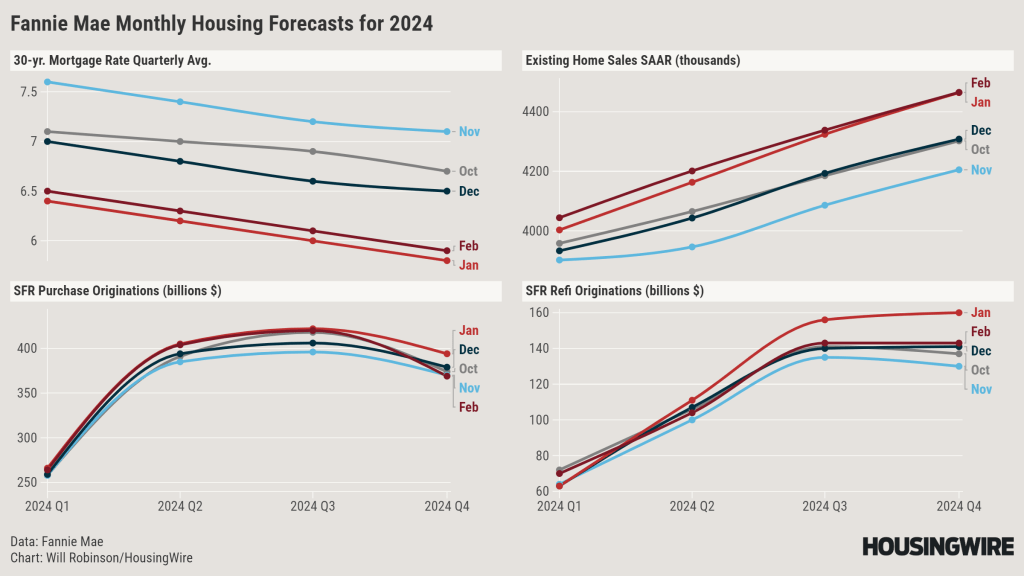Good news! The national economy is growing; unemployment is low; corporate revenues are up.
For housing and mortgage professionals, however, these apparent boons spell trouble. They signal that the economy is still running hot — or at least more than lukewarm — and that inflation may still need more cold water from the Federal Reserve to slow down.
The cold water comes in the form of the Fed continuing its high federal funds rate, which results in high mortgage rates. Real estate professionals need no reminder of how catastrophic high rates have been for housing inventory, sales and prices.
Rosy economic news is unlikely to nudge the Federal Open Market Committee (FOMC) to start cutting the federal funds rate when they meet next week.
Fannie Mae seems to share this sentiment. Although it has not yet released its monthly forecast for March, its February forecast showed a slightly dimmer view of the housing market prospects for 2024.
Economic forecasts
Fannie Mae publishes quarterly forecasts for the economy at large and housing specifically each month. Its outlook for 2024 got more conservative in February, with the anticipation of faster gross domestic product (GDP) growth, stickier core inflation, stronger employment retention and further delays in cuts to the federal funds rate than it forecast in prior months.
Persistent inflation in February worsens the outlook for imminent rate cuts, as does continued job growth. We’ll have to see if this makes Fannie Mae more conservative in its March estimates.
GDP growth, core inflation and unemployment were stumbling blocks for Fannie Mae in 2023 as forecasters and economists alike wrestled with the likelihood of a recession and various hypothetical timelines for getting inflation under control.
Ultimately, in its outlooks last year, Fannie Mae underestimated the economy’s ability to keep growing and keep people employed.
The economy’s strength was overshadowed in fourth-quarter 2023 by the fact that core inflation’s year-over-year growth came in lower than expected, putting inflation within reach of the Fed’s target of 2% annual growth. This pleasant surprise sparked enthusiasm that rate cuts could be imminent, but that enthusiasm has mellowed, and most experts do not expect rate cuts from this month’s meeting of the FOMC.
Thus far in 2024, economic strength and persistent inflation seem to be surprising experts again.
Housing forecasts
Despite the economic headwinds that Fannie Mae now foresees through 2024, its outlook for the housing market remains rosier than its late 2023 forecasts.
February’s outlook is slightly worse than January’s across most indicators, but forecasts released in the opening months of this year were more optimistic than those in the final three months of 2023.
Because Fannie Mae’s assumptions last year were based on a slowing economy and moderating rates, its housing outlook for most indicators was too optimistic for the majority of 2023.
Most of Fannie Mae’s housing projections are based largely on the movements of mortgage rates, which have an outsized impact on everything else in the housing market. In its February forecast, the government-sponsored enterprise still foresees mortgage rates falling below 6% — an important milestone for many housing experts — by the fourth quarter of this year.
Rates, however, are still hovering above 7% at the moment, according to HousingWire’s Mortgage Rates Center.
Fed predictions
When the FOMC meets March 19-20, its members will again be asked to make their own forecasts of the best policy path for rates to follow. It will give us a dot plot, like the one below from December’s FOMC meeting, that summarizes each member’s thoughts on the federal funds rate.
Few expect any rate cuts to result from this meeting, but it will give housing and mortgage professionals a fresh indication of how imminent or delayed the eagerly awaited rate cuts may be.





